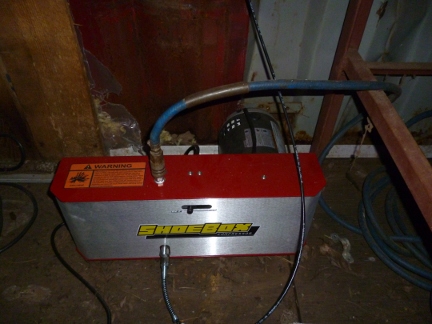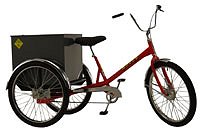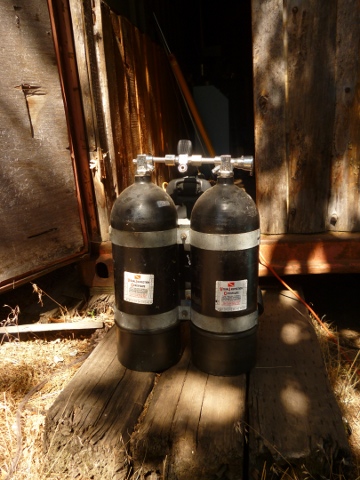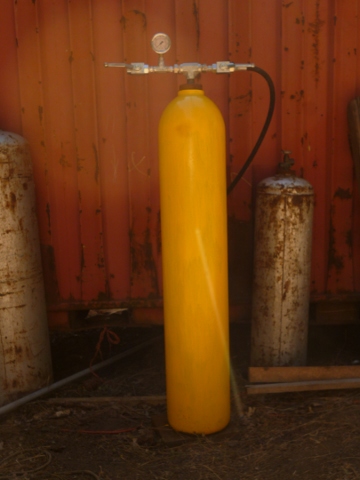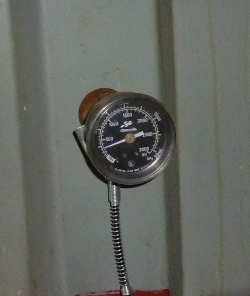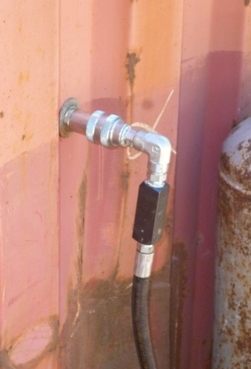July 2013 Update
July 19, 2013 Progress has been slow this spring, partially because of the demands of other projects, but mostly because we're getting into the point in the project where funding is becoming more of an issue. For example, many of the components needed for the early parts of the project, such as work on the GEK, could be purchased at local hardware stores. By contrast, parts for the Biomass Compressor need to be acquired from companies that specialize in pressure fittings capable of withstanding thousands of pounds per square inch. Naturally, such fittings are expensive, often costing ten times what a common plumbing fitting of would cost. We're delighted to report that the work is moving ahead nicely these days because a donation has enabled us to acquire a Shoebox compressor. It's an impressive little unit that's capable of compressing air to 4,000 pounds per square inch (psi), or expressed another way, that's 260 times standard air pressure, i.e. 260 bar. While the Shoebox's output is small compared to what the Biomass Compressor will do, it's a very useful intermediate tool that will help move the work forward in important ways during this period of development and testing.
An important use we'll be making of the Shoebox compressor is to improve our educational and fundraising presentations this coming fall. This past April, we did an demo at Portland State University's Earth Day celebration. This demo allowed us to showcase our ability to convert wood chips into a combustible fuel that can substitute for nature gas. This fuel, like natural gas, can be piped and then used to operate a stove or to generate electricity. The Shoebox compressor will allow us to improve the impact of our demo by demonstrating one way that wood chips can be used to power local transportation in a way that is user friendly and easy on the environment. That will be our first public example of the concept of using woody biomass to go beyond the bounds of the traditional CHP model of biomass utilization (Combined Heat and Power) and enter the realm of CHPF (Combined Heat Power and Fuel). This is an exciting stage in the project's development since the basic concept of CHP is well established; it's going beyond that to a CHPF system powered by woody biomass that's what special about B2M. For millennia, people have been burning wood to provide heat. Over the last century, people have learned to use the energy stored in biomass to both generate electricity and provide domestic heat using the heat given off by the generation process--what electrical generation plants refer to as "waste heat." Systems that put "waste heat" to use are known as Combined Heat and Power; CHP for short. Here's a link to a impressive presentation by Aegis Energy Services touting their natural gas powered CHP system. As a rule of thumb for CHP plants, one third of the energy bound up in the biomass can be converted into electricity, with two-thirds of the biomass' energy leaving the generation facility in the form of heat, generally as hot water. CHP works well in situations in which all that hot water can be put to use, thereby eliminating the need to purchase additional energy to drive central heating systems. A key difference between Aegis' system and B2M is that an apartment building using the Aegis system would have a natural gas bill to pay, whereas a forested village using B2M wouldn't. In fairness, I should note that Aegis' system is "plug and play" with the only work the owner need to is to write out a check to the gas company each month--B2M is very much an owner-operator system. Accordingly, one thing a B2M village will need is a way to transport wood chips from the surrounding forest to it's processing plant, and that will likely involve some sort of transportation fuel. While it's tempting to think of a fuel as sources of energy, it's not; it may be more helpful to think of a fuel as a way to store and transport energy so that you can have power when and where you want it. One technologically simple way to do that is by using a tank of compressed air to power an air motor, something which automotive repair shops do all the time. If the concept of air-powered vehicles is of interest, Wiki has an excellent article on Compressed Air Cars. What the Shoebox will enable us to do in the short term is to modify a three-wheel mountain bike such as this one made by Industrial Bicycles and designed to move modest amounts of cargo, and modify it to run on compressed air.
Now that we've been able to satisfy the PSU Safety Office that our demo is safe, we're looking forward to putting on a series of woody biomass demonstrations at colleges and universities throughout the Pacific Northwest. One goal will be to raise the awareness of the potential that the gasification of woody biomass has for meeting a range of local energy needs in a renewable way. There are also two other reasons we'll be putting on these demos: to attract the interest of students who would be good candidates for a Windward internship, and to attract the interest of potential donors to help fund the project by becoming True Fans.
A trike powered by compressed air wouldn't have the range of one that's powered by an internal combustion engine burning the same amount of compressed woodgas, but that's not a concern in this application. And actually, powering a transport trike with compressed air offers some real advantages; for example, an IC engine would continue consuming fuel while one stopped to chat with interested folk, all the while giving off exhaust fumes and making noise. By comparison, an air-powered trike would wait silently‒consuming no energy and generating no exhaust fumes‒until the "gas" pedal was pressed and off you went! Pressure Testing the SystemA very important reason for acquiring a Shoebox compressor was that it now enables us to run safety checks on our equipment, checks that confirm the structural integrity of the components thereby helping us to build in appropriate safety margins. For example, the fourth stage of the Biomass Compressor will pressurize wood gas to 3,000 psi (200 bar), and it's important to be able to confirm that the parts we're assembling will actually perform as they're supposed to at that pressure. We appreciate that the parts we're acquiring to do this work are rated for those pressures‒but ratings are not a sufficient substitute for actual testing.Once the Shoebox had arrived and was up and working, the first test we wanted to conduct involve hydrotesting the high-pressure storage tank that will be filled by the fourth stage of the Biomass Compressor. In addition, testing the tank would also involve testing the various components that will be part of that set up. The sort of test involved is called a hydrotest because the vessel being tested is first filled to the brim with water. Gases are compressible; liquids are not. If a pressurized storage tank that is filled with water fails, it will spray out a small amount of water and then start to dribble; i.e. nothing too dramatic is likely to happen. By first testing a tank that's filled with non-compressible water, we gain confidence that it will perform as we want it to when it's filled with compressible gases. It took some time to track down the adapters we needed to hook up the Shoebox to our system, but the folks at Shoebox were very helpful and steered us in the right direction. The next step was to fill the high-pressure tank with water. In that process, we confirmed that the capacity of the tank is 10 1/2 gallons.
Examination revealed a small leak at the tank inlet. Turned out that both the tank's threads and the pipe nipple's threads were "straight" threads. That's a problem because in order to get a seal, at least one of the threads needs to be tapered so that the threads will jam and seal. That discovery meant delaying the test as we waited for the delivery of a high-pressure nipple with tapered thread. With that problem solved, it was time to turn on the Shoebox again and restart the hydrotest. One of the key safety protocols we're using involves a physical separation from the equipment being tested and the person monitoring the test. In this case, the tank being tested was outside the shipping container, while the person monitoring the test sits inside. That way, if something does fail, there's a solid steel wall between the failure and the person.
Here's a pic of the pressure gauge that's located inside the shipping container at the place where air compressed by the Shoebox passes through the container's steel wall to the outside. This gauge enables the observer to monitor how the pressure test is proceeding without being exposed to the system when its under pressure.
Here's a pic of the other side of that pressurized line showing the quick disconnect coupling that allows us to uncouple the inside components from the outside gear. The black rectangular piece is a check valve; it's there to ensure that compressed gases from the system can't flow back into the interior of the PowerLab. It only took the Shoebox about twenty minutes to bring the pressure in the tank up to 4,000 psi, a good 1,000 psi higher than the operational pressure this tank will be working with. That provides a solid safety margin, especially given that the tank will be fitted with a pressure release valve that will ensure that the pressure in the tank doesn't go over 3,000 psi. Also, the Biomass Compressor is computer controlled using sensors to monitor the pressure at multiple locations. Each stroke of each stage of the compressor has to be initiated by the control computer based on pressure readings; if a sensor fails and doesn't generate a signal, the computer won't initiate a compression stroke, so it's very difficult to imagine how the compressor could "run away" and exceed the target pressure. As we bring on each section of the Biomass Compressor, we'll be repeating a variation of this procedure, using the Shoebox to bring each section of the compressor up to its working pressure plus an appropriate safety margin. |
